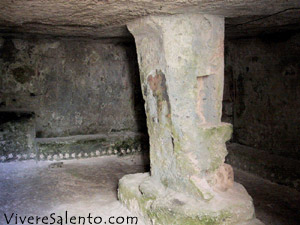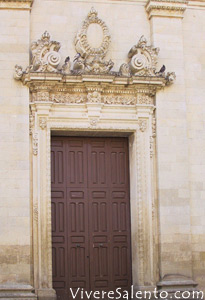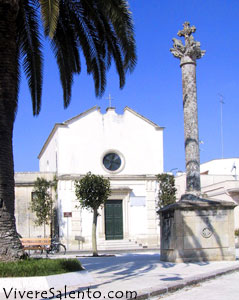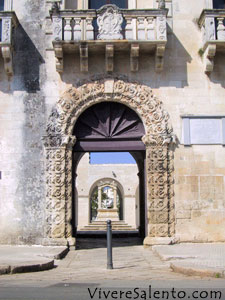|
|

The Baronal Palace belonged to the family
Cicala, but in 1734 it was bought by the Granafeis. A historical
 document
( 1744) describes the characteristics of this palace that quite that year had to
be completed. The architect who planned it was probably Mauro Manieri while the
paintings were made by Serafino Elmo in 1775. The Mother Church, dedicated to
the Madonna, was built on a very small pre-existing church (in bad conditions)
in 1700. There is only a nave and some papier-maché statues representing the
Holy Heart of Jesus Christ (XX century), St. Giorgio (XX century), the Deposed
Christ (1922), a wooden organ (1741) and some highly appreciated paintings like
that of St. Oronzo dating back to the XVII century. The Convent and the Church
of the Dominicans were built in 1513 and restored in 1709. Over the portal of
the convent you can see the coat of document
( 1744) describes the characteristics of this palace that quite that year had to
be completed. The architect who planned it was probably Mauro Manieri while the
paintings were made by Serafino Elmo in 1775. The Mother Church, dedicated to
the Madonna, was built on a very small pre-existing church (in bad conditions)
in 1700. There is only a nave and some papier-maché statues representing the
Holy Heart of Jesus Christ (XX century), St. Giorgio (XX century), the Deposed
Christ (1922), a wooden organ (1741) and some highly appreciated paintings like
that of St. Oronzo dating back to the XVII century. The Convent and the Church
of the Dominicans were built in 1513 and restored in 1709. Over the portal of
the convent you can see the coat of arms of the family De Riccardis since the Dominicans since the priest De
Riccardis designated them as his heirs. The Dominicans, having so much power,
influenced the life of the village for about a century. The Church dei Caduti,
previously dedicated to St. Rocco, has a very sober façade; inside you can
admire a prestigious canvas realized by Raffaele Maccagnani in 1909 and the
statues of St. Filippo Neri and of St Ignazio. The Chapel of the Carmine, of
ancient origins, has been restored recently. The Chapel of the Lady of the
Graces, situated near the railway station, was restored in 1849. The Chapel of
St. Vito was an old medieval construction and it was rebuilt in 1600. The Chapel
of the Lady of the Farauli dates back to the XVI century and both the interns
and the portal are absolutely wonderful. Also the Church of the Madonna of the
Angels was built in the XVI century and inside there is the painting of the
Vergin Mary considered miraculous. The influence of the Byzantine culture is
testified by the presence of the Crypt of St. Sebastian and the Crypt of St.
Peter. The former has got two aisles and a square plant: inside you can admire
the paintings of the Announciation and of St. Sebastian (1115). The latter is an
aisless crypt and it is square-shaped too. The
arms of the family De Riccardis since the Dominicans since the priest De
Riccardis designated them as his heirs. The Dominicans, having so much power,
influenced the life of the village for about a century. The Church dei Caduti,
previously dedicated to St. Rocco, has a very sober façade; inside you can
admire a prestigious canvas realized by Raffaele Maccagnani in 1909 and the
statues of St. Filippo Neri and of St Ignazio. The Chapel of the Carmine, of
ancient origins, has been restored recently. The Chapel of the Lady of the
Graces, situated near the railway station, was restored in 1849. The Chapel of
St. Vito was an old medieval construction and it was rebuilt in 1600. The Chapel
of the Lady of the Farauli dates back to the XVI century and both the interns
and the portal are absolutely wonderful. Also the Church of the Madonna of the
Angels was built in the XVI century and inside there is the painting of the
Vergin Mary considered miraculous. The influence of the Byzantine culture is
testified by the presence of the Crypt of St. Sebastian and the Crypt of St.
Peter. The former has got two aisles and a square plant: inside you can admire
the paintings of the Announciation and of St. Sebastian (1115). The latter is an
aisless crypt and it is square-shaped too. The
 ancient
paintings date back to the XII century and as the whole crypt, are in bad
conditions. Porta Filia , built by the middle of the XIV century, is very
interesting from the historical and artistical point of view. At Sternatia there
are not only churches and palaces but also case a corte, oil-presses and farms
as "Li Mezzi" Farm, "Caraffa" Farm, "Le Carrare" Farm and "Caloere" Farm. The Patron
of the country is St. George and he is celebrated on August 22nd. ancient
paintings date back to the XII century and as the whole crypt, are in bad
conditions. Porta Filia , built by the middle of the XIV century, is very
interesting from the historical and artistical point of view. At Sternatia there
are not only churches and palaces but also case a corte, oil-presses and farms
as "Li Mezzi" Farm, "Caraffa" Farm, "Le Carrare" Farm and "Caloere" Farm. The Patron
of the country is St. George and he is celebrated on August 22nd.

The nickname of the inhabitants of
Sternatia is "Sciddhi" , a word meaning "dogs". According to an ancient legend at Sternatia there was a good-looking woman, Cristina, who enchanted all
the "Sciddhi," thus causing furious quarrel in many families. When it got dark
men used to enter her house and stay with her. Some people, being very curios,
tried to spy them; Cristina sometimes disguised herself as ghost and whispered,
with a grisly voice, dreadful phrases thus making them go away.
legend at Sternatia there was a good-looking woman, Cristina, who enchanted all
the "Sciddhi," thus causing furious quarrel in many families. When it got dark
men used to enter her house and stay with her. Some people, being very curios,
tried to spy them; Cristina sometimes disguised herself as ghost and whispered,
with a grisly voice, dreadful phrases thus making them go away.
|